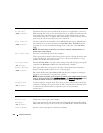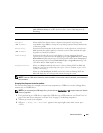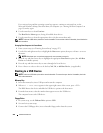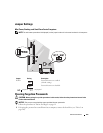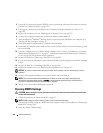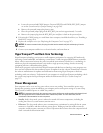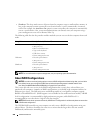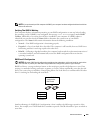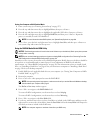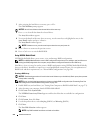
270 Advanced Features
NOTE: In a RAID level 0 configuration, the size of the configuration is equal to the size of the smallest drive
multiplied by the number of drives in the configuration.
RAID Level 1 Configuration
RAID level 1 uses a data-redundancy storage technique known as mirroring to enhance data integrity.
When data is written to the primary drive, the data is also duplicated, or mirrored, on the second drive in
the configuration. A RAID level 1 configuration sacrifices high data-access rates for its data redundancy
advantages.
If a drive failure occurs, subsequent read and write operations are directed to the surviving drive. A
replacement drive can then be rebuilt using the data from the surviving drive.
NOTE: In a RAID level 1 configuration, the size of the configuration is equal to the size of the smallest drive in the
configuration.
Configuring Your Hard Drives for RAID
Your computer can be configured for RAID, even if you did not select a RAID configuration when the
computer was purchased. For an explanation of RAID levels and their requirements, see "About RAID
Configurations" on page 268. For information on how to install a hard drive, see "Installing a Hard Drive"
on page 65 for your mini tower computer or "Installing a Hard Drive" on page 126 for your desktop
computer.
You can use one of two methods to configure RAID hard drive volumes. The first method uses the
NVIDIA MediaShield ROM utility and is performed before you install the operating system onto the
hard drive. The second method uses NVIDIA MediaShield and is performed after you have installed the
operating system and NVIDIA RAID drivers.Both methods require that you set your computer to RAID-
enabled mode before you begin.
hard drive 1
segment 1
segment 2
segment 3
hard drive 2
segment 4
segment 5
segment 6
segment 1 duplicated
segment 2 duplicated
segment 3 duplicated
segment 4 duplicated
segment 5 duplicated
segment 6 duplicated
serial ATA RAID
configured for
RAID level 1



